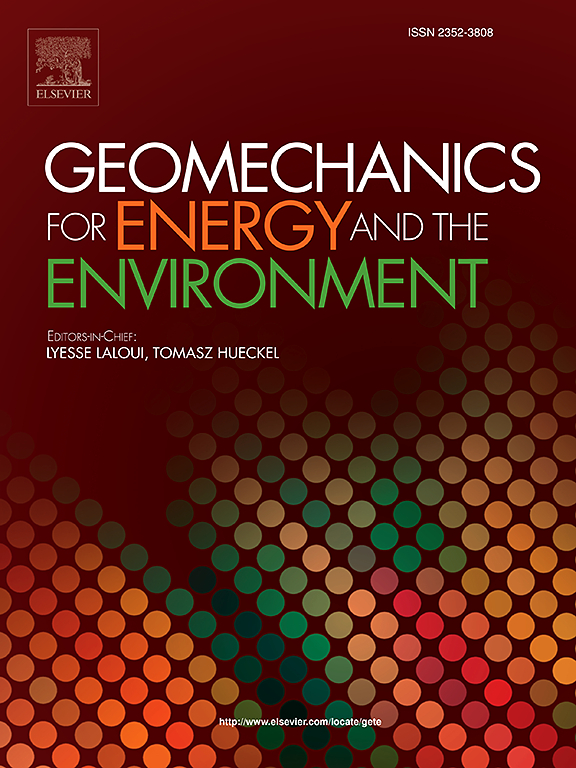结晶岩中水力学和热力学断裂过程的系统模型和实验方法
IF 3.3
2区 工程技术
Q3 ENERGY & FUELS
引用次数: 0
摘要
本文介绍了DECOVALEX 2023项目“晶体岩石裂缝网络中流体流动、剪切、热和反应过程的安全评估”的任务G SAFENET的主要发现。它采用系统的实验方法来数值模拟脆性岩石中的力学(M)、水力学(HM)和热力学(TM)断裂过程。任务小组介绍、应用并比较了各种数值方法,包括连续介质和非连续介质方法,以模拟相关的破裂过程。任务G基于三个关键实验:Freiberg、GREAT cell和KICT实验,分别分析M、HM和TM过程。经典HM和THM基准练习作为共同基础,使用了孔隙弹性介质中平面直线不连续的解析解(Sneddon和Lowengrub, 1969)和热孔隙弹性介质中的点热源(Booker和Savvidou, 1985), (Chaudhry等人,2019)。这些解决方案也可作为粗糙裂缝和简单裂缝网络的参考。在GREAT细胞实验的基础上,导出了一套系统的新的基准案例。在Freiberg试验的基础上,采用微观和宏观两种方法对恒定法向载荷(CNL)试验进行了分析。GREAT细胞实验提供了一个数据库,用于评估各种岩石样品(树脂、灰岩、片岩)在旋转应力场三轴试验中的力学和水力学响应。裂缝渗透率被确定为旋转应力场中正应力的函数。采用KICT实验研究了热致剪切滑移和膨胀过程。SAFENET Task通过为选定的基准练习提供免费访问的Jupyter笔记本,为DECOVALEX中的开放科学概念做出了贡献。本文章由计算机程序翻译,如有差异,请以英文原文为准。
A systematic model- and experimental approach to hydro-mechanical and thermo-mechanical fracture processes in crystalline rocks
The paper presents the key findings of Task G SAFENET of the DECOVALEX 2023 project “Safety Assessment of Fluid Flow, Shear, Thermal and Reaction Processes within Crystalline Rock Fracture NETworks”. It utilizes a systematic and experimental approach to numerically simulate mechanical (M), hydro-mechanical (HM), and thermo-mechanical (TM) fracture processes in brittle rocks. The Task team introduced, applied, and compared a wide range of numerical methods, including both continuum and discontinuum methods, for simulating related fracture processes. Task G is based on three key experiments: the Freiberg, GREAT cell, and KICT experiments, which analyze M, HM, and TM processes respectively. Classic HM and THM benchmark exercises serve as a common basis by using analytical solutions for a plane line discontinuity in a poro-elastic medium (Sneddon and Lowengrub, 1969) and a point heat source in a thermo-poro-elastic medium (Booker and Savvidou, 1985), (Chaudhry et al., 2019). These solutions also serve as a reference for rough fractures and simple fracture networks. A systematic set of new benchmark cases has been derived based on the GREAT cell experiments. An analysis of the constant normal load (CNL) experiment has been conducted using micro- and macroscopic approaches, based on the Freiberg experiment. The GREAT cell experiments provided a database for evaluating the mechanical and hydro-mechanical responses of various rock samples (resin, greywacke, gneis) in triaxial tests with a rotational stress field. Fracture permeability was determined as a function of normal stresses in the rotational stress field. The KICT experiments were used to investigate thermally induced shear slip and dilation processes. The SAFENET Task contributed to the Open Science concept in DECOVALEX by providing a freely accessible Jupyter notebooks for selected benchmark exercises.
求助全文
通过发布文献求助,成功后即可免费获取论文全文。
去求助
来源期刊

Geomechanics for Energy and the Environment
Earth and Planetary Sciences-Geotechnical Engineering and Engineering Geology
CiteScore
5.90
自引率
11.80%
发文量
87
期刊介绍:
The aim of the Journal is to publish research results of the highest quality and of lasting importance on the subject of geomechanics, with the focus on applications to geological energy production and storage, and the interaction of soils and rocks with the natural and engineered environment. Special attention is given to concepts and developments of new energy geotechnologies that comprise intrinsic mechanisms protecting the environment against a potential engineering induced damage, hence warranting sustainable usage of energy resources.
The scope of the journal is broad, including fundamental concepts in geomechanics and mechanics of porous media, the experiments and analysis of novel phenomena and applications. Of special interest are issues resulting from coupling of particular physics, chemistry and biology of external forcings, as well as of pore fluid/gas and minerals to the solid mechanics of the medium skeleton and pore fluid mechanics. The multi-scale and inter-scale interactions between the phenomena and the behavior representations are also of particular interest. Contributions to general theoretical approach to these issues, but of potential reference to geomechanics in its context of energy and the environment are also most welcome.
 求助内容:
求助内容: 应助结果提醒方式:
应助结果提醒方式:


